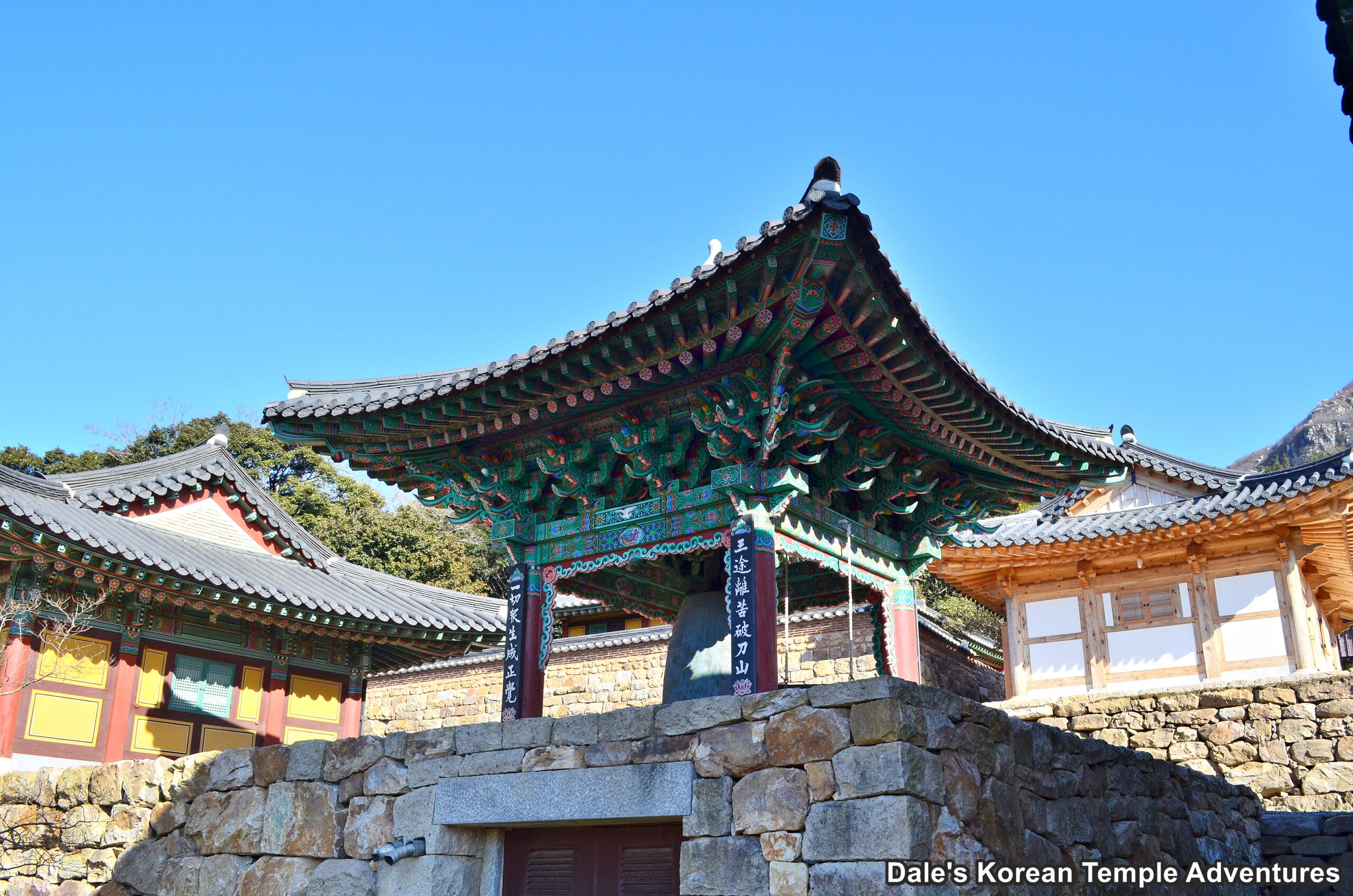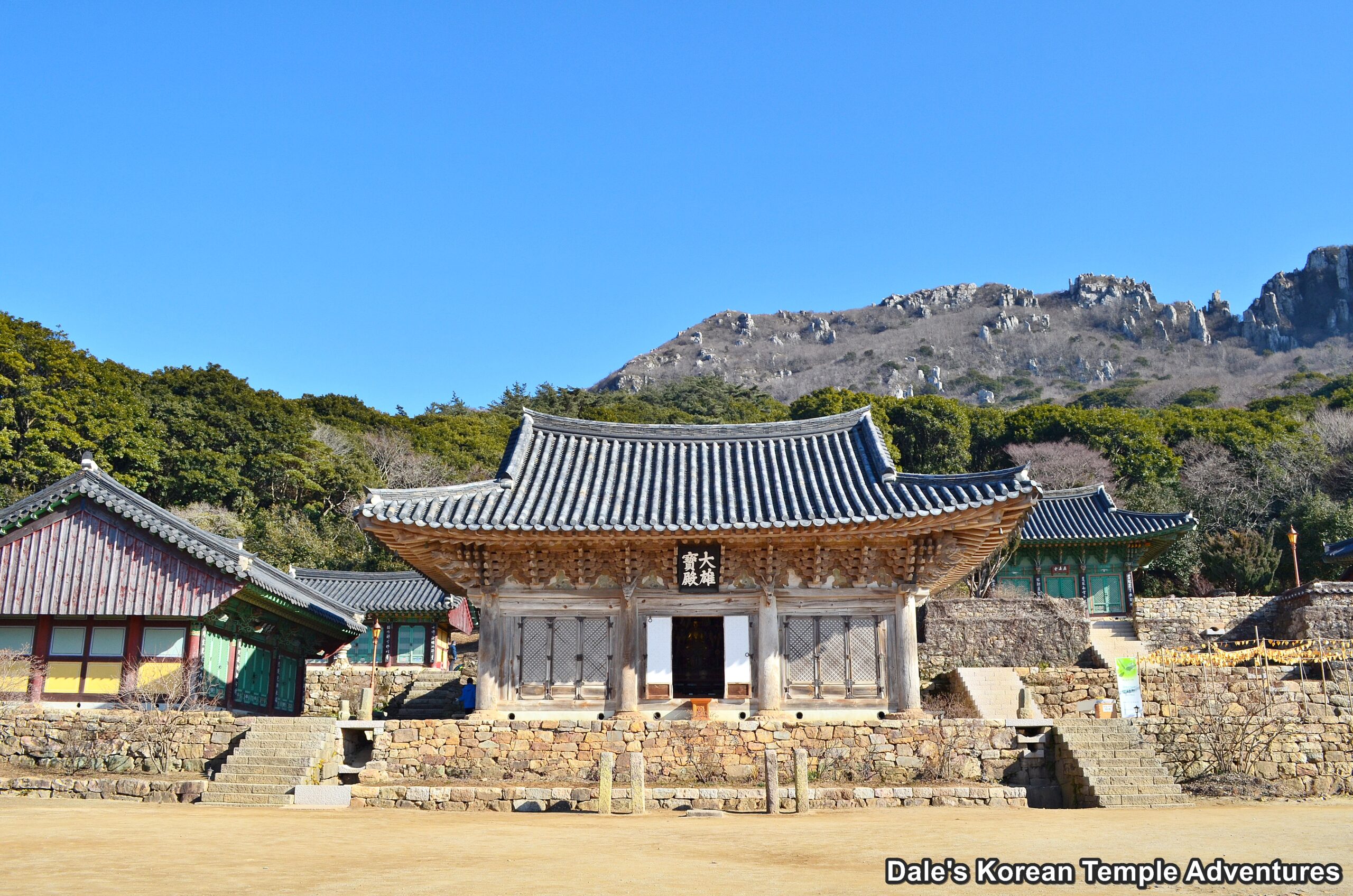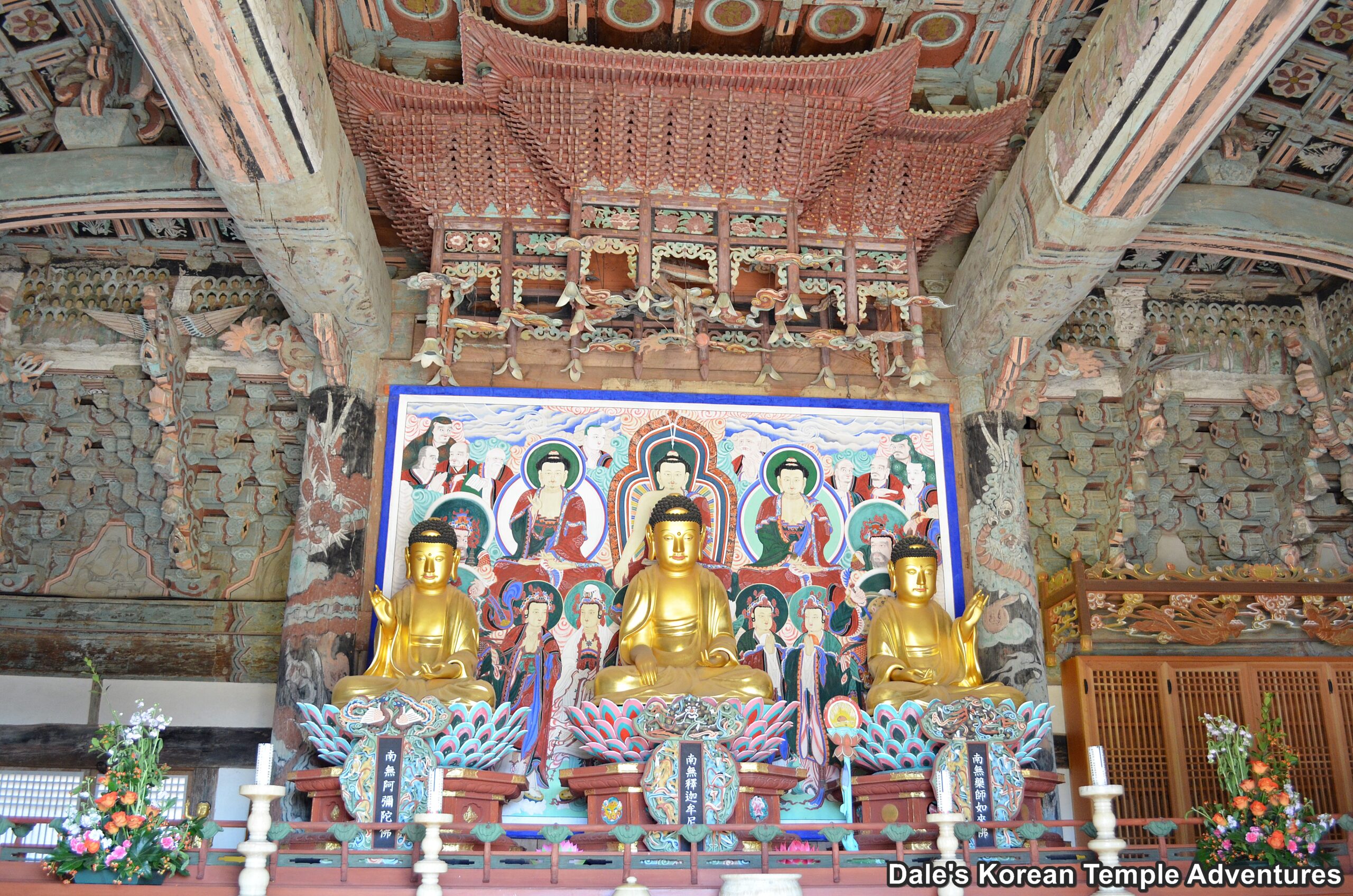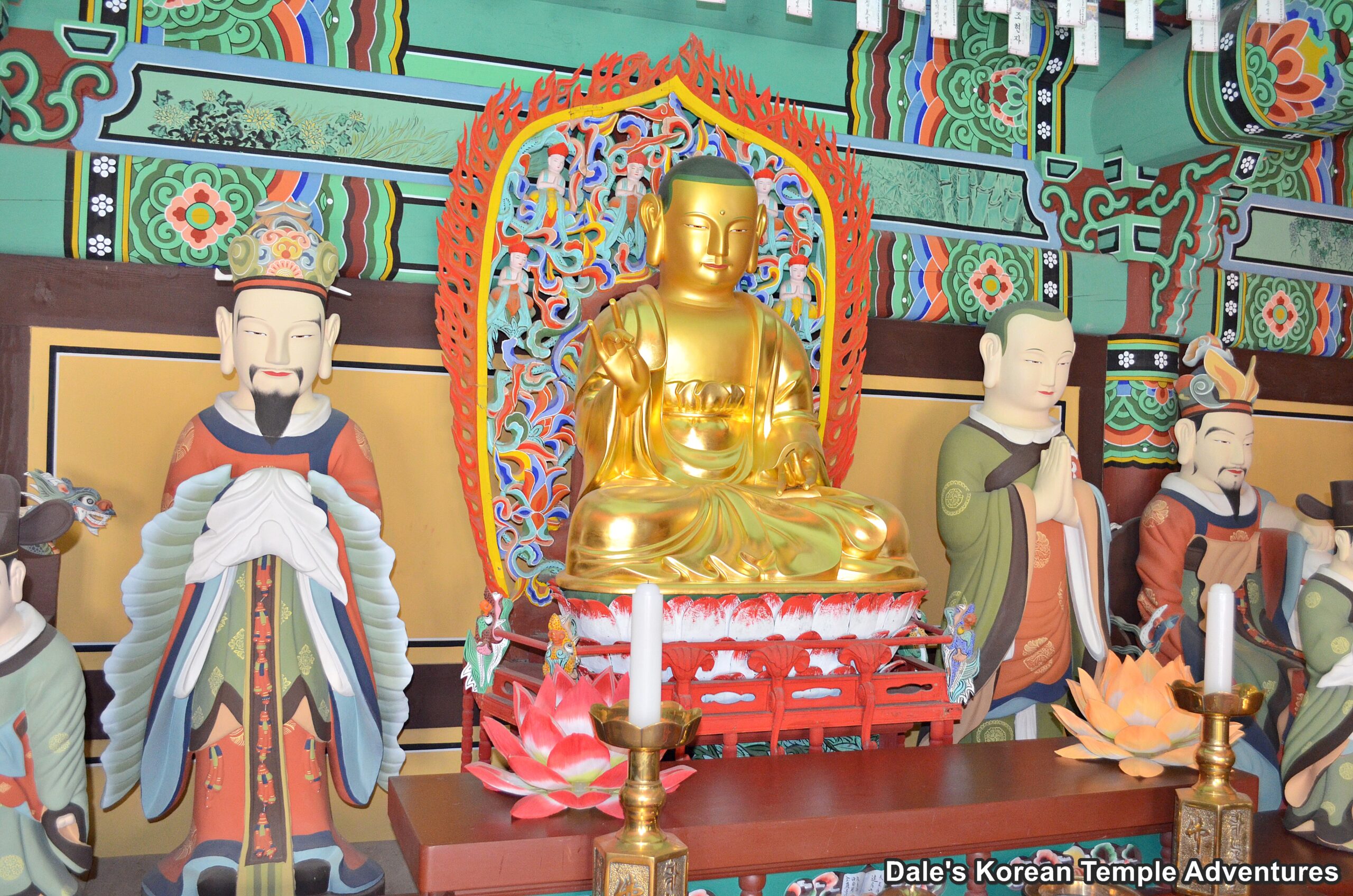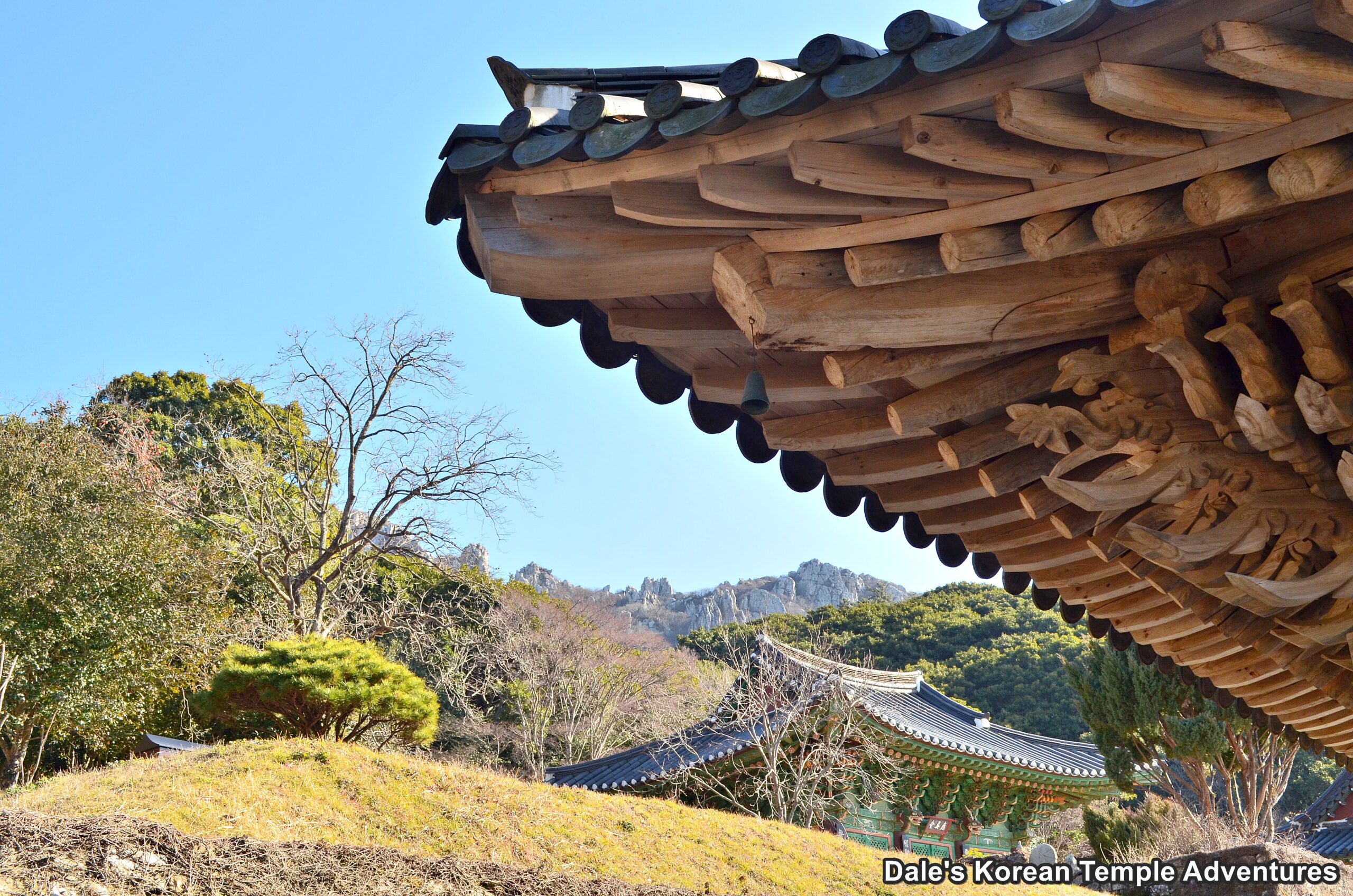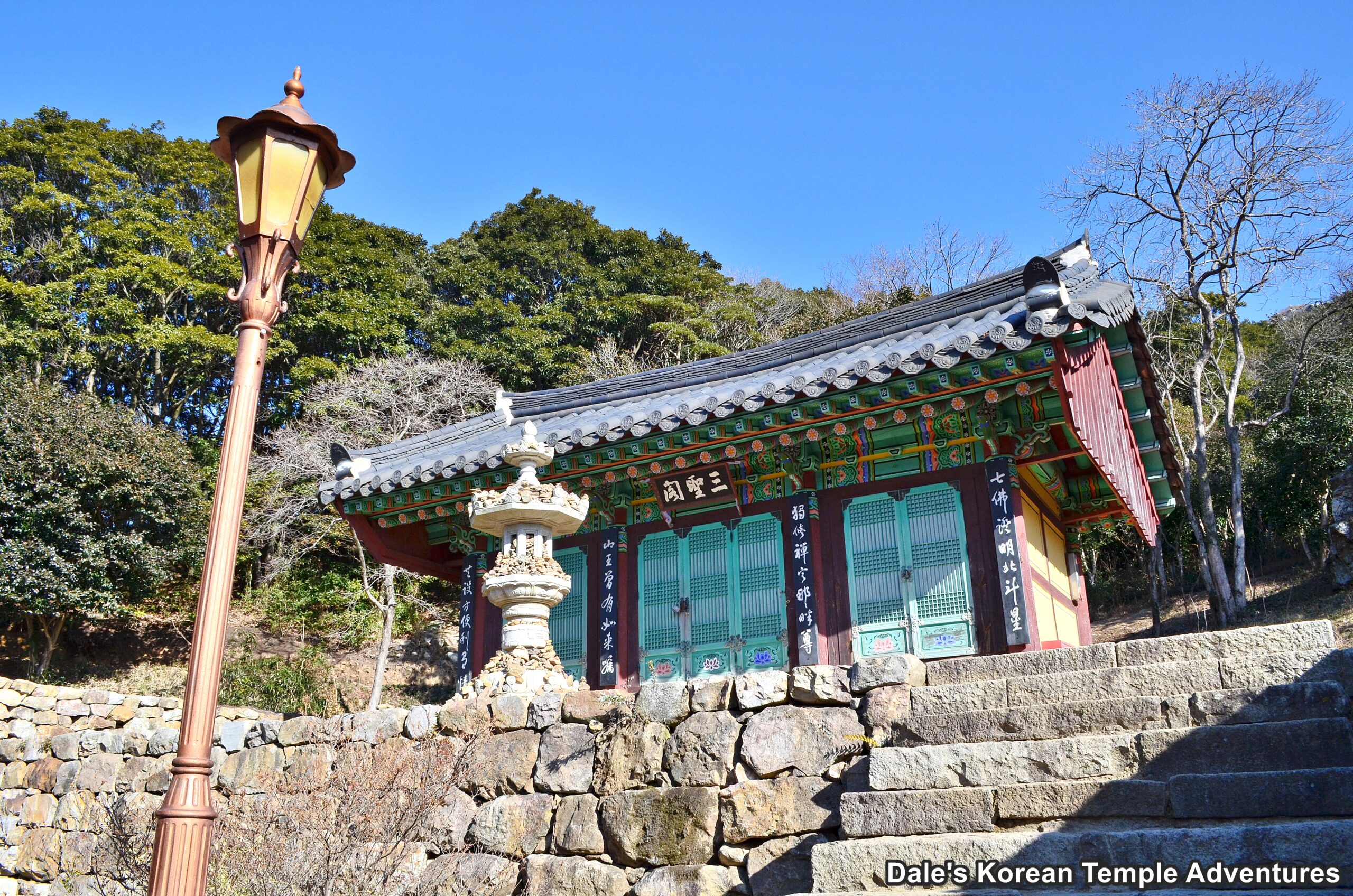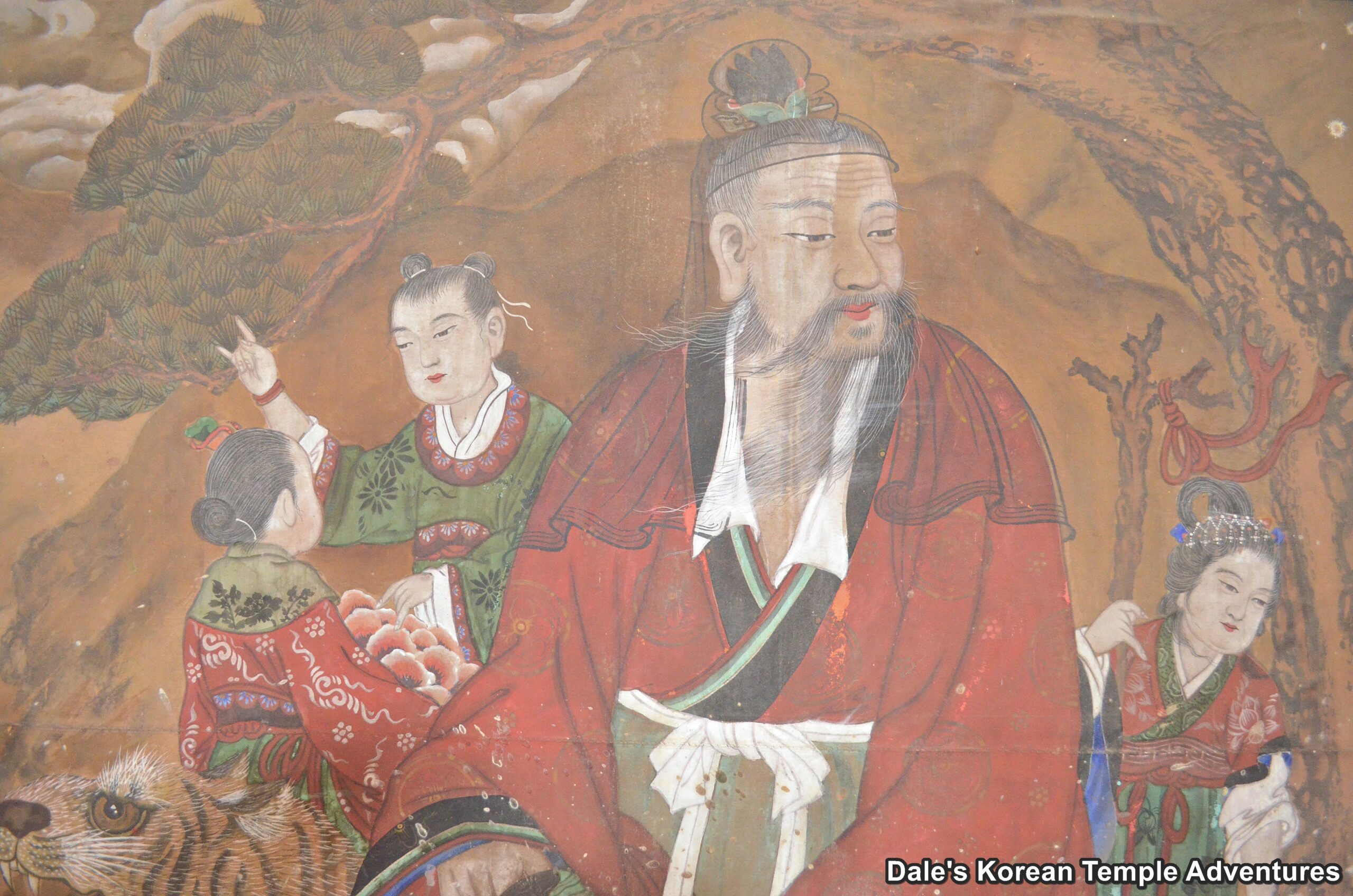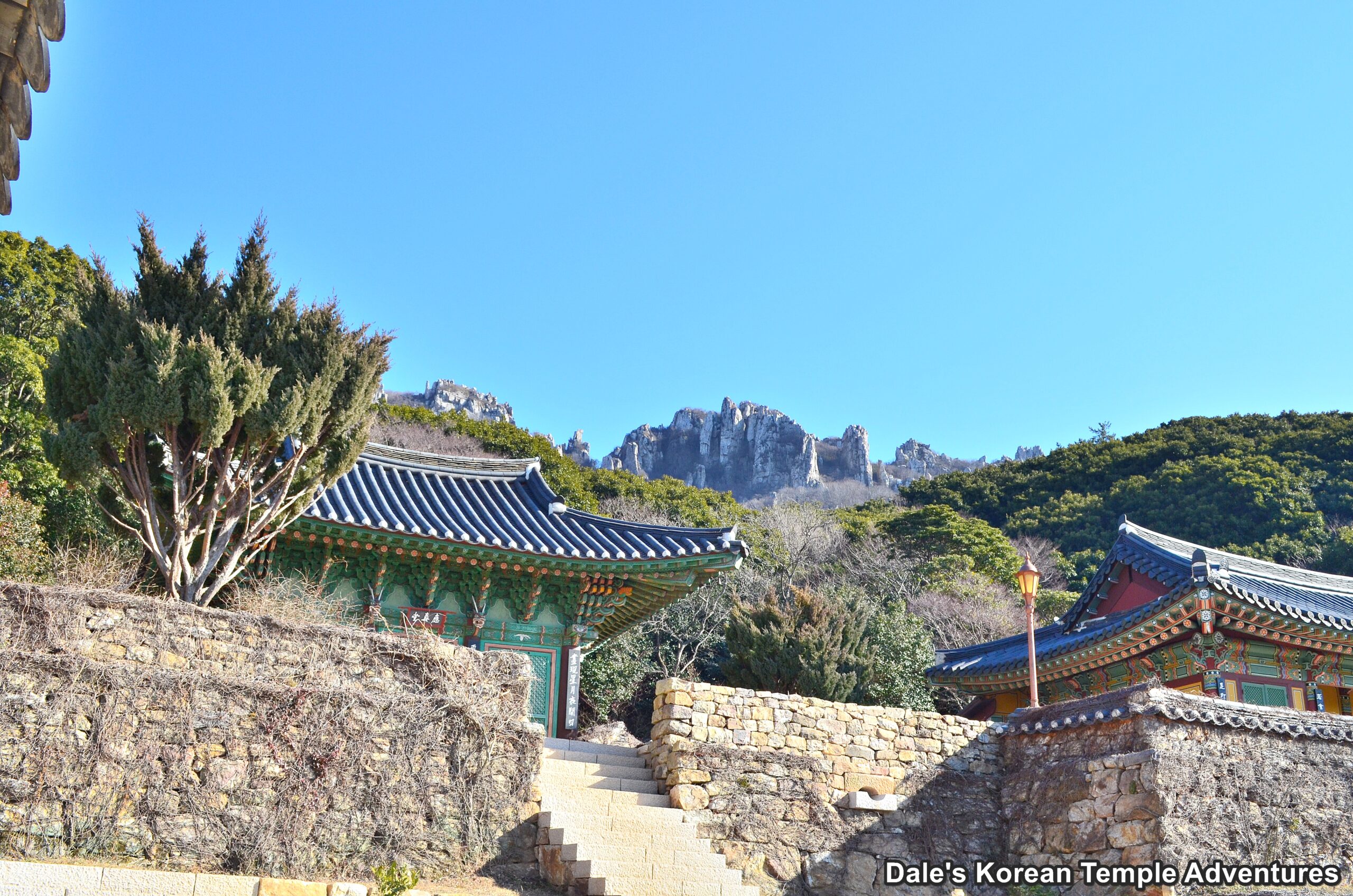Mihwangsa Temple – 미황사 (Haenam, Jeollanam-do)
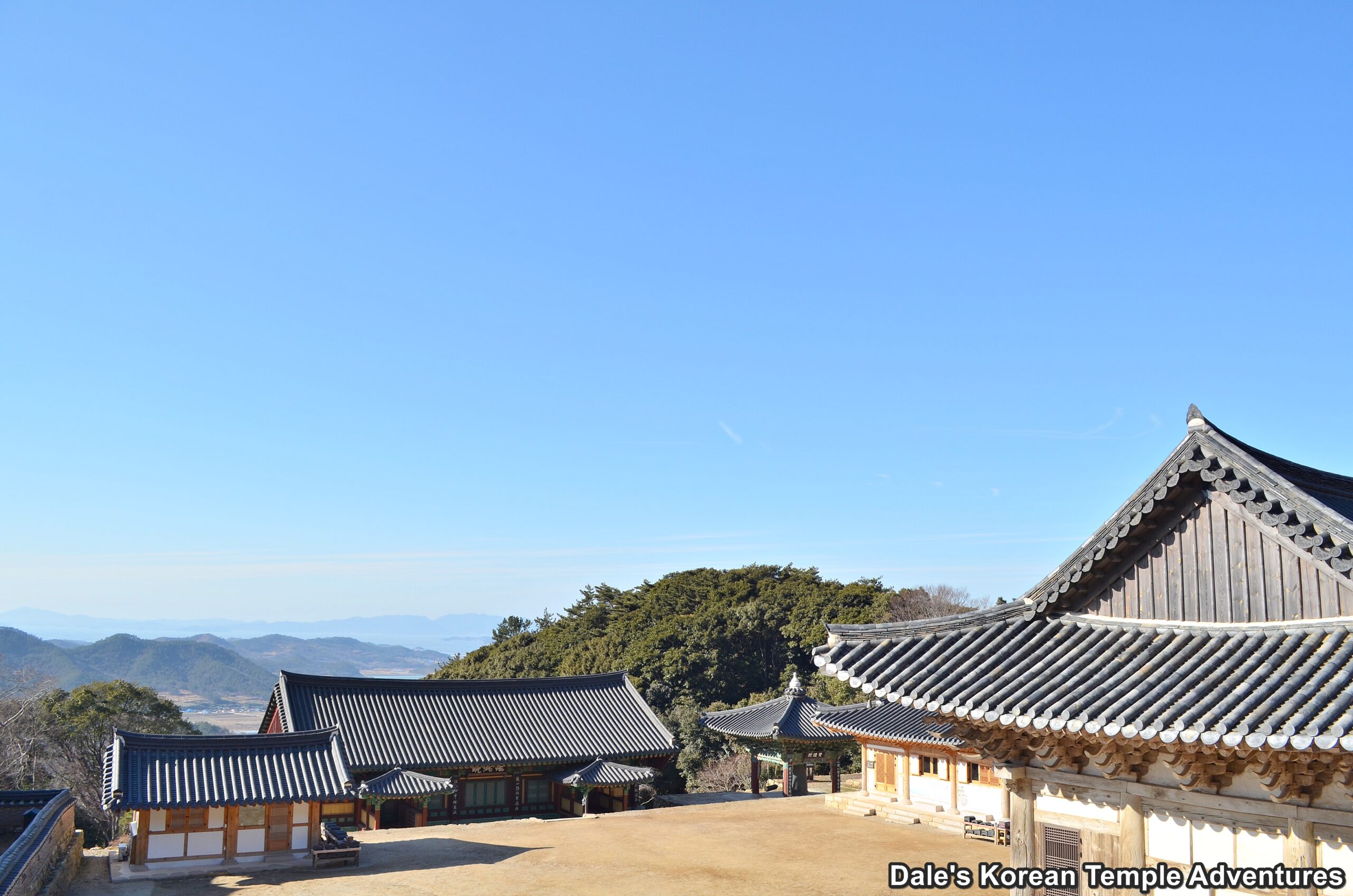
Temple History
Mihwangsa Temple, which means “Beautiful Yellow Temple” in English, is located in Haenam, Jeollanam-do. According to the temple myth from the Samguk Yusa (Memorabilia of the Three Kingdoms), which is one of the more interesting temple myths that you’ll find in Korea, Mihwangsa Temple was first founded in 749 A.D. Mihwangsa Temple, which is located to the west of Mt. Dalmasan (489 m), is the southernmost temple on the mainland Korean peninsula. Also, Mihwangsa Temple enjoys beautiful views of the South Sea off in the distance.
As for the creation myth surrounding Mihwangsa Temple, which also gives the temple its name, it’s definitely one of the most intriguing of its kind. In 749 A.D., a stone ship arrived at a port off the coast of Mt. Dalmasan. On board the ship stood a man adorned in gold. He was standing with an oar in his hands. On shore, people heard a beautiful hymn extolling the virtues of the Buddha coming from the ship. However, when people went to see where the music was coming from, the stone ship quickly retreated from the shore. And just as soon as people gave up inquiring about the ship, the ship returned to its former position off the shore. This went on for several days until the monk Uijo-hwasang, along with two other monks and neighbouring residents, offered up prayers to the ship. Finally on board the ship, Uijo-hwasang and the residents found eighty copies of the Avatamsaka Sutra, seven copies of the Lotus Sutra, statues of Birojana-bul (The Buddha of Cosmic Energy), Munsu-bosal (The Bodhisattva of Wisdom), and forty saints, sixteen Nahan, and fifty great enlightened masters, as well as some taenghwa (altar murals). But most amazing of all was the large golden box that they opened. Housed inside this golden box was a black rock that they broke open. A tiny black ox emerged from this black rock. The black ox rapidly became quite large in size. Later that night, Uijo-hwasang had a dream about a golden robed man from the stone ship. This robed man told Uijo-hwasang that he was in fact the king of Wujeon-guk, India. The king told Uijo-hwasang in this dream that Mt. Dalmasan was an auspicious place to build a temple for ten thousand Buddhas. So the king asked Uijo-hwasang to place all of the sutras and statues from the ship on the back of the large, black ox. And wherever the large, black ox ended up laying down, Uijo-hwasang should build a temple there. The next day, Uijo-hwasang followed the king’s instructions from his dream. At first, the ox laid down on a spot on the eastern side of the mountain. Here Uijo-hwasang later built a temple named Tonggyosa Temple, which unfortunately no longer exists. The ox continued upon its journey, where it finally arrived and laid down in a deep valley west of the craggy peaks of Mt. Dalmasan. This is where Mihwangsa Temple was finally built, and where the numerous sutras and statues were enshrined between these two temples that Uijo-hwasang built. So Mihwangsa Temple gets its name in part from “Mi,” which was the beautiful mooing sound that the ox was making; and “hwang” from the golden robed man on the stone ship. And the name of the neighbouring mountain, Mt. Dalmasan, which means “Mt. Dharma” in English, comes from hosting all the Buddhist sutras on it in Mihwangsa Temple.
During the Goryeo Dynasty (918-1392), scholars and officials from China’s Song Dynasty (960-1279 A.D.) visited the temple between 1264 to 1294. This highlights the fact that the temple was even known to the Chinese at this time. Also at this time, there were twelve hermitages directly associated with Mihwangsa Temple on Mt. Dalmasan. During the Imjin War (1592-1598), Mihwangsa Temple was destroyed by the invading Japanese. The temple was rebuilt in 1598, starting with the Daeungbo-jeon Hall. The Daeungbo-jeon Hall was then later repaired in 1754.
In total, Mihwangsa Temple is home to four Korean Treasures, including the Daeungbo-jeon Hall. Additionally, Mihwangsa Temple participates in the popular Korean Temple Stay program.
Temple Layout
You first make your way up towards Mihwangsa Temple under the stately Iljumun Gate and the recently constructed Cheonwangmun Gate. In the centre of the newly constructed Cheonwangmun Gate is a Yunjangdae, or “Revolving Scriptures Library Pillar” in English. A Yunjangdae is a spinning bookshelf that’s used in Buddhist ceremonies. It’s believed that by spinning the Yunjangdae that enshrines Buddhist scriptures, a person can achieve good karma. Basically, by spinning a Yunjandae, a person can achieve the same level of good karma by spinning it as they would by reading Buddhist sutras. As for the Four Heavenly Kings themselves, they are extremely modern in composition. They are tall and slender, and they stand upon four Zodiac Generals.
A little further up another set of stone stairs, and passing under the Jaha-ru Pavilion, you’ll finally gain entry to the main temple grounds at Mihwangsa Temple. Probably the very first thing you’ll notice is a tall white Bodhidharma statue to your left. This is then joined to the left by the Jong-ru (Bell Pavilion), which houses the solitary Brahma Bell at Mihwangsa Temple.
Up another set of stone stairs, and on the other side of the Jaha-ru Pavilion, you’ll see the Daeungbo-jeon Hall. The Daeungbo-jeon Hall has no murals adorning its aged exterior walls. However, look down at the foundation stones that help support the main pillars of the Daeungbo-jeon Hall. You’ll notice that these foundation stones have a lotus flower design. As for the interior, and resting on the main altar, you’ll see a triad of statues centred by Seokgamoni-bul (The Historical Buddha). This statue is joined on either side by Amita-bul (The Buddha of the Western Paradise) and Yaksayeorae-bul (The Buddha of the Eastern Paradise, and the Medicine Buddha). This triad is meant to symbolize the Buddhist idea of samsara. And if you look up at the ceiling of the main hall, you’ll see Sanskrit writing instead of the more traditional floral patterns. Hanging on the far left wall is a Shinjung Taenghwa (Guardian Mural). The Daeungbo-jeon Hall was first built in 1598, and it’s Korean Treasure #947.
To the left of the Daeungbo-jeon Hall is the Myeongbu-jeon Hall. Inside the Myeongbu-jeon Hall, you’ll find a statue of Jijang-bosal (The Bodhisattva of the Afterlife) on the main altar. This central image is surrounded by a fiery nimbus and the Siwang (The Ten Kings of the Underworld). And all of these statues are then joined by a couple dozen attendants.
Behind the Daeungbo-jeon Hall, and in the upper courtyard, are two additional temple shrine halls. The one to the left is the Samseong-gak Hall. Housed inside the Samseong-gak Hall are three older murals dedicated to Chilseong (The Seven Stars), Dokseong (The Lonely Saint), and Sanshin (The Mountain Spirit).
The other shrine hall in the upper courtyard is the Eungjin-dang Hall, which is Korean Treasure #1183. The Eungjin-dang Hall was rebuilt in 1751. Inside the Eungjin-dang Hall, you’ll find a solitary statue of Seokgamoni-bul (The Historical Buddha) on the main altar. This golden statue is joined by sixteen statues of the Nahan (The Historical Disciples of the Buddha) on the main altar. Interestingly, the Nahan statues are backed by fading murals of the Historical Disciples of the Buddha. It’s from the Eungjin-dang Hall that you get the best view of the seaside landscape off in the distance.
A couple interesting points. One, Mihwangsa Temple and the surrounding Mt. Dalmasan are considered Korean Scenic Site #59. Secondly, and to the rear of the temple grounds, is a monument written in Hanja that says “tomal” on it. This literally means “end of the mainland” in English, which is most definitely where Mihwangsa Temple is situated.
How To Get There
You can get to Mihwangsa Temple from the Haenam Intercity Bus Terminal. From here, you’ll need to catch a bus that heads to Wando. This bus leaves every ten to sixty minutes, depending on the time of the day. The first bus leaves at 5:50 a.m., and these buses run throughout the day until 9:10 p.m. You’ll need to get off at the Weolsong-ri stop. The bus ride should last about sixty minutes. From here, you’ll need to either grab a taxi for the remaining ten minute drive to get to the temple.
Overall Rating: 7.5/10
Not only does Mihwangsa Temple have one of the more intriguing creation myths, but it’s also one of the most scenically located temples in all of Korea with beautiful views of the South Sea from the heights of Mt. Dalmasan. In addition, you can enjoy the historic Daeungbo-jeon Hall and Eungjin-dang Hall, as well. While you’ll have to travel a fair distance to the southern tip of the peninsula, the destination of Mihwangsa Temple is well worth it in the end.

